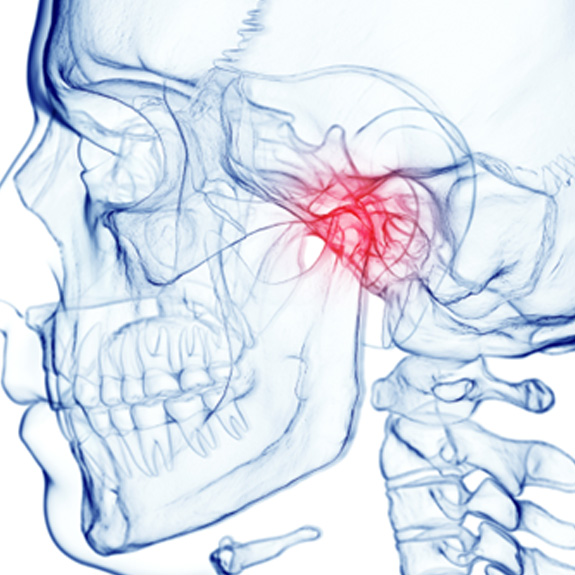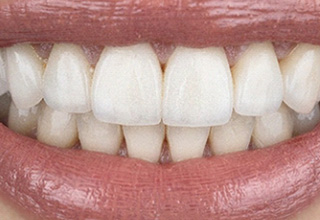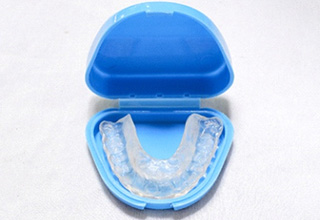TMJ Treatment – Weatherford
Put a Stop to Jaw Pain & Headaches
Your mind will naturally jump to your teeth and gums when you think about your oral health, but how much consideration do you give your jaw? The lower jaw is connected to your skull by a joint known as the TMJ. If this joint becomes injured or stressed, it can lead to a TMJ disorder, or TMD. Living with a TMD means enduring jaw pain, headaches, neck and shoulder pain, and other forms of discomfort on a regular basis. Fortunately, with the help of Dr. Novak, Dr. Johannsen, and Dr. Collins, you can find relief from your TMJ-related pain. Call us today to set up an appointment and learn more about your options for treatment.
Why Choose Beacon Dentistry of Weatherford for TMJ/TMD Therapy?
- Expertly Customized Occlusal Splints
- Advanced Dental Diagnostic Technology
- A Fun & Lively Team of Dental Experts
What Is TMJ Disorder?

Your TMJ, also known as your temporomandibular joint, is a small set of hinges located in front of your ears. This joint allows your lower jaw to move up and down when you speak, laugh, and talk. The TMJ is one of the most complex joints in the body, so it can be disturbed by a misaligned bite, teeth grinding, and other factors. When it happens, you have TMJ disorder, or TMD.
Symptoms of TMJ Disorder

There are various symptoms of TMD. Here are some of the most prominent ones that are experienced.
- Headaches: One of the most underdiagnosed causes of frequent headaches is TMD. The jaw muscles become tense, strained, and overworked, so it is easy for this to affect the nearby muscles in the head.
- Ear Pain: Since the TMJ is located near the ears, having a dysfunction joint can easily result in ear pain. It can also cause ringing in the ears, called tinnitus.
- Face/Jaw Pain: Jaw stiffness and pain are the most commons symptoms of TMD. It can be difficult to chew comfortably, and lockjaw is common.
- Bruxism: Teeth clenching and grinding can be caused by daily stress, a misaligned bite, and TMD. This usually happens during sleep and can overwork the jaw muscles, leading to additional pain.
Types of TMJ Treatment

Checking the TMJ is actually a regular part of every dental checkup. In addition to examining your jaw, we may also ask you about symptoms that might point to the presence of a TMD, such as chronic pain or hearing a clicking sound whenever you open your mouth. If we suspect that you might have a TMD, we’ll perform some tests to diagnose the issue and try to narrow down the underlying cause (which might be an injury, arthritis, teeth grinding, or an uneven bite). Once we have figured out the source of your pain, we can start putting together a treatment plan. In addition to the solutions below, we may also offer a few tips for taking care of your TMJ at home, such as avoiding hard or crunchy foods as much as possible.
Occlusal Splint

An occlusal splint is a simple oral appliance that can be customized to address your specific TMD-related issues. One of its most important functions is to gently shift the jaw forward to help it reach its natural resting position. This gives your TMJ a chance to relax and recover, thus relieving your pain. As another benefit, an occlusal splint can act as a barrier between the upper and lower rows of teeth, which means that the nighttime grinding that is often associated with TMD won’t do further damage to your smile. After a few months of wearing your occlusal splint on a regular basis, you’ll eventually find that you’re no longer experiencing TMD symptoms on a daily basis.
Equilibration/Occlusal Adjustment

When the TMJ is unable to reach its natural resting position, the muscles and ligaments of the jaw will start to suffer from a considerable amount of tension that eventually leads to pain. In many cases, the TMJ can’t reach the proper position because the teeth don’t come together correctly. Thus, to solve the issue, we’ll have to make minor changes to your teeth until they all come together evenly. This process is known as an occlusal adjustment, but it’s also referred to as equilibration. This usually involves removing small amounts of enamel from your smile, but we may also need to build specific teeth up by placing crowns.
TMJ Treatment FAQs
Can TMJ Be Cured Permanently?
One of the first things patients want to know when they learn that they’re suffering from a TMJ disorder is whether or not their condition is chronic. However, the answer depends significantly on your unique situation and the cause of your aching jaw.
For instance, if you’ve been grinding your teeth more than usual due to a period of greater stress, then your condition might resolve itself long-term once tension has passed. Also, some treatments, like occlusal adjustments and splints, are designed to permanently address the underlying cause of your jaw pain.
Is TMJ Treatment Safe?
Yes, TMJ treatments are considered safe when they are provided by a qualified professional, like one of our Beacon Dentistry of Weatherford providers. We will work with you to identify the root problem and suggest minimally invasive and conservative methods for addressing it, if possible. We offer occlusal splints and adjustments, which have been proven to be a safe way to address TMJ-related concerns.
Our providers share decades of experience, so you can trust that you’re in good hands. Plus, we offer multiple treatment options, so if one isn’t right for your circumstances, you can still benefit from another.
How Long Does it Take for a TMJ Splint to Work?
Our team in Weatherford can provide a custom-fitted oral appliance to wear at night that gently shifts your jaw into its natural resting position. This can alleviate the tension on the disc joints connecting your jawbone to your skull, giving them enough of a reprieve to begin to heal.
You might notice some symptoms disappear more quickly than others because it takes time for your jawbone, TMJ, and surrounding muscles, ligaments, and tissues to acclimate to their updated positions. After about six weeks, most people notice significant improvements, though it can take three to six months before their issues are fully resolved.
How Long Does Occlusal Equilibration Take for TMJ?
TMJ occlusal adjustments and equilibrations involve changing the shape of your teeth to ensure they come together correctly. Whether we’re adding dental bonding to perfect your alignment or removing thin amounts of enamel, you’re likely to notice a difference relatively quickly afterward. However, the length of your treatment affects how quickly you’ll notice results, and varies from person to person.
For example, if you require one, two, or three adjustments, it won’t take as long to notice an even distribution of your bite force as it would for those requiring four or more. Thankfully, the appointments to make the corrections are typically brief.
I Need a Checkup & Cleaning I am Looking for a Dentist for My Child I am Concerned about Bleeding Gums I Have a Cavity or Broken Tooth I am Missing One or More Teeth I am Unhappy with My Smile I Want a Straighter Smile I am Scared of the Dentist I am in Pain & Need Help View Our Services

